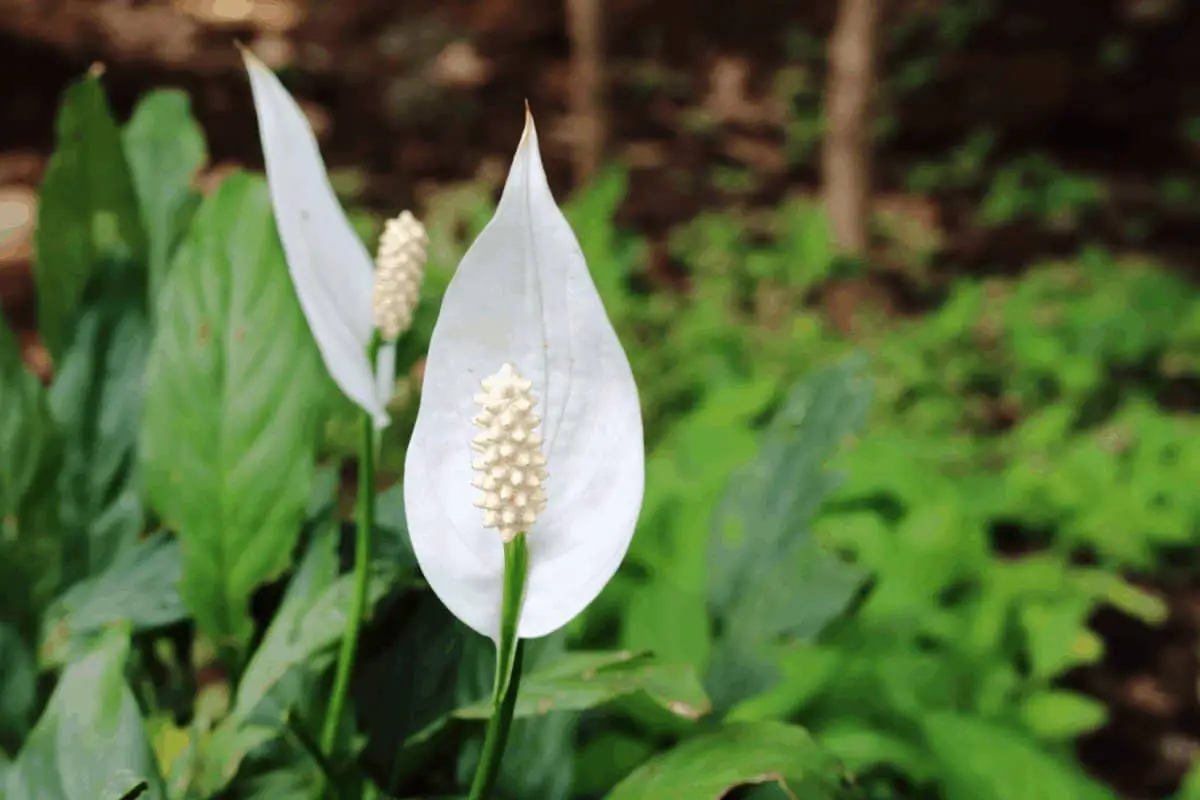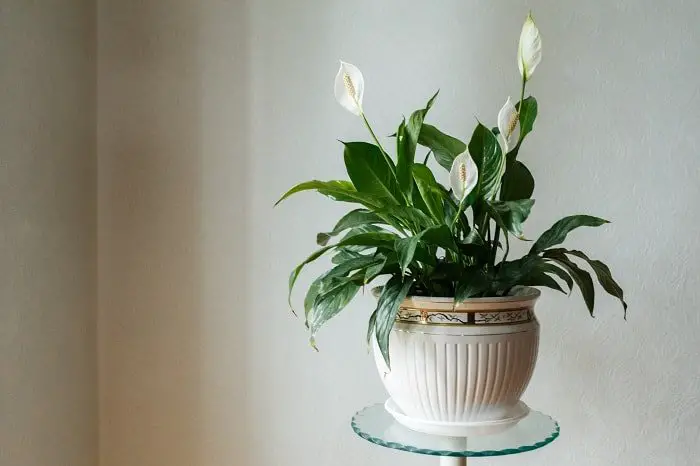Last Updated on April 25, 2022 by Fabiola L.
Peace lilies have long been a staple of indoor gardeners, so much so that many call this beautiful white flower the ‘closet plant.’ Unlike many other blooms, the peace lily is well-suited to the typical indoor environment, thriving with little sunlight, a moderate to high temperature, and watering on a weekly basis. Some gardeners even enjoy keeping them around because of their air cleaning capabilities, which have been recognized by NASA as being some of the most spectacular. Check out this guide to see just what you should do to craft the best environment possible for your plant and answer the common question: How often do you water a peace lily?
Because of its reputation for being an easy plant, many amateur and expert gardeners alike are quick to adopt the peace lily and add it to their household. But there continues to exist some contradicting advice about how to best care for the white flower, including just how often it needs water.
You can buy a beautiful Peace Lily here.
How Often Do You Water a Peace Lily?
It is easy to tell when to water a peace lily. Unlike other plants, the peace lily will let the gardener know when it wants a drink because the leaves will begin to droop from a lack of moisture. This occurs at least once a week. It is important to keep the soil damp so there is enough water to reach and care for the roots. Always check the soil before adding more water – if it is still moist, leave the lily alone and wait another day or two before watering.
Your peace lily will need more water during the summer growing season than during the winter when it enters its own form of hibernation. The plant can be kept hydrated by watering with a regular can or spritzing the flower and soil in the pot with distilled or mineral water using a spray bottle.
If you forget to water the peace lily, don’t worry. Even if it has been longer than a week since your last hydration session, you can water and spritz right away. No matter how much the fronds have started to sag, they can recover quickly. Unlike regular lilies, the peace lily can respond well to treatment and return to normal.
As a final note, peace lilies are highly sensitive to chlorine. If you live in a region which heavily chlorinates the water on a regular basis, avoid using it to take care of your plant. Instead, use bottled or distilled water. Try to avoid using filtered tap water from your kitchen sink, as the chlorine will still remain and the lily is likely to react negatively.
How the Peace Lily Differs from Other Lilies
Although they are called peace lilies, these flowers actually aren’t real members of the same scientific family. Instead, they just resemble the flowers and are easy to grow. They are a member of the Araceae family and therefore have some differences, including high toxicity for domestic animals like dogs and cats.
Unlike other lilies, the peace lily is characterized by having a single white petal that stands vertically. It is at the top of a long, thick stem and has the majority of its leaves near the base. Peace lilies grow one petal at a time, so don’t expect more to develop until the original has passed. It is possible to grow multiple peace lilies in a single container, but it is crucial to leave enough space for the roots to stretch.
Are Peace Lilies Poisonous?
The American Society for the Prevention of Cruelty to Animals (ASPCA) lists the peace lily as one of the most toxic houseplants for dogs and cats. It’s important to keep pets away from any peace lilies that are grown indoors, as they are not regular lilies and can cause a variety of concerning symptoms like vomiting, difficulty swallowing, oral irritation, and burning of the mouth, lips, and tongue.
When you water your peace lily, it’s okay to move it to better reach the soil. However, remember to place it back in a secure location so any dogs or cats at home can’t reach it. The poison is only transferred when your pet has a chance to nibble or snack on the plant, so a high place is the best choice if you have particularly adventurous cats or dogs.
How to Care for on a Regular Basis
Peace lilies have often been considered a fundamental plant for amateur gardeners because they are simple and easy to maintain. This flower requires a light, partial shade and appears unaffected by fluorescent lights, making it excellent for indoor growth. It is easy to tell when a peace lily has been overexposed to light, as the leaves start to yellow and brown. Try to keep each plant 6 to 8 ft. away from a window at all times.
Besides moderating sun exposure, it’s also important for the gardener to keep an eye on the ambient temperature. Peace lilies grow best in areas between 65 and 85 degrees Fahrenheit and will die rapidly in cold temperatures. Try to keep the room humid and avoid the temptation to touch the thermostat.
Finally, peace lilies are some of the easiest to care for when it comes to pests. Their waxy leaves and toxic nature mean most bugs leave the peace lily alone. Even though the flower can suffer from spider mites, aphids, and mealybugs, these are pests that can literally be wiped away with a damp cloth. If they do take root in your lily, simply spray with a pesticide soap.
Conclusion
The peace lily continues to be one of the most enduring household plants because of its simple care and maintenance. Even if you lack a green thumb or have a history of killing the most basic of plants, you can still successfully raise a peace lily to maturation. Just remember to adjust the environment as necessary, pay attention to where you place the plant, and water as needed or on a weekly basis to get the best results.
FAQs
How do I know when my peace lily needs water?
When peace lilies need water, their leaves droop or twist. If the plant is not watered within a couple of days, the leaves turn brown and begin to fall off. If you catch it early enough, you can save your peace lily by watering it well. Water thoroughly until water comes out the drainage hole. If the peace lily is in a pot, dump out any water that has built up in the saucer.
Even if you can't see the peace lily's roots, it is sometimes possible to determine whether your peace lily needs water by lightly poking the soil. If it feels dry an inch or two beneath the surface, then it's time to water. You can also take a peek at peace lilies' roots if you want to check their health. Healthy peace lilies have roots that are white in color. If the peace lily has brown or black roots, then it is not receiving enough water.
You should water peace lilies at least once a week when they are actively growing during spring and summer; slightly less frequently in autumn; and even less frequently during winter, only when necessary. For peace lilies that are planted in the ground, deep watering once a week is usually adequate. If you live in an area with hot summers, peace lilies may need to be watered more frequently.
Do peace lilies need sunlight?
Another thing Peace lilies need sunlight. They should be placed in an area where they will get at least four hours of direct sunlight each day. If you can't provide that much sunlight, you can supplement with grow lights.
If you can provide a peace lily with water and sunlight, it will be happy and healthy. But if you can't meet those requirements, don't worry - peace lilies will still live but may not flower as often.
Where should I place a peace lily in my house?
The peace lily (Spathiphyllum) is a popular houseplant that is known for its ability to remove toxins from the air. It is important to remember that the peace lily needs water, so make sure to place it in a location where it will be able to get enough. A peace lily should never be placed in a direct sunbeam, as it will dry out the soil quickly. Try placing it in a bathroom or near a sunny window. peace lilies can also be placed on a windowsill or countertop. Make sure to keep an eye on the peace lily's water level and water it when the soil feels dry to the touch. Fertilize the peace lily every three months, while also removing dead leaves regularly. A peace lily makes a great houseplant!
Should I cut the brown tips off my peace lily?
This is a question for the hot weather. If you live in a region where the temperature remains above 70 degrees Fahrenheit, then you should cut off the brown tips on your peace lily.
In order to produce healthy flowers that will last longer, it's recommended that peace lilies are trimmed to 4 inches above the soil line as this is where new growth begins. This will help prevent stress and diseases in your plants and also make them last longer with less watering.
Find more information about 11 Amazing Plants That Look Like Peace Lily
Tony Manhart is a passionate gardener who has been tending to gardens for over 20 years. He takes pride in creating beautiful outdoor spaces with plants, trees, and shrubs that can thrive in any environment. He loves to share his knowledge with others and has taught classes on gardening basics and advanced techniques. He is committed to sustainability, using natural and organic methods to create and maintain gardens. He also works with local organizations to create green spaces for communities. When he’s not gardening, Tony enjoys hiking, reading, and spending time with his family.




